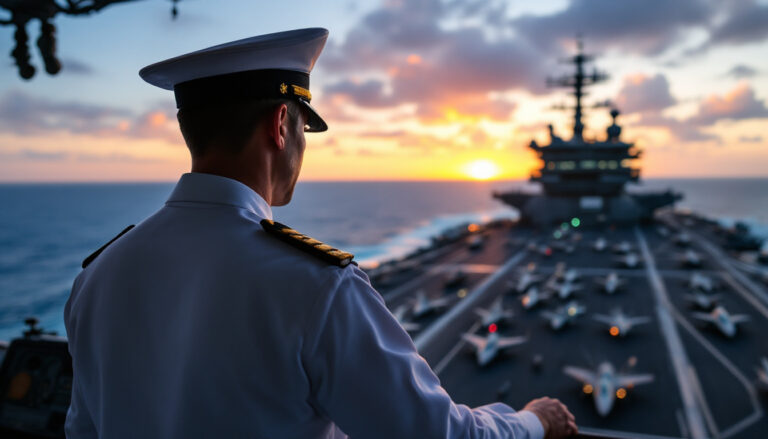The Chief of Naval Operations (CNO) serves as the highest-ranking naval officer in the U.S. Navy and acts as the principal naval advisor to the President, Secretary of Defense, and Secretary of the Navy.
The CNO reports directly to the Secretary of the Navy for the command, utilization of resources, and operating efficiency of the operating forces of the Navy and its shore activities.
As a member of the Joint Chiefs of Staff, the CNO works with other service chiefs to advise the President and Secretary of Defense on military matters.
Key Responsibilities
- Commands all naval operating forces and shore installations
- Implements maritime strategy and naval policies
- Manages Navy personnel, equipment, and resource allocation
- Oversees training and readiness of naval forces
- Represents the Navy in joint military planning
Leadership Structure
The CNO leads the Office of the Chief of Naval Operations (OPNAV), located at the Pentagon.
Direct Reports
- Vice Chief of Naval Operations (VCNO)
- Master Chief Petty Officer of the Navy (MCPON)
- Deputy Chiefs of Naval Operations (DCNOs)
- Directors of major staff offices
Appointment Process
The President nominates the CNO, who must be confirmed by the Senate.
The CNO serves a four-year term and can be reappointed for additional terms.
Current Contact Information
Office of the Chief of Naval Operations
2000 Navy Pentagon
Washington, DC 20350-2000
Historical Impact
The position of CNO was established by Congress in 1915 with the creation of the Office of the Chief of Naval Operations.
Working With Other Military Branches
- Coordinates joint operations with other service branches
- Participates in Joint Chiefs of Staff meetings
- Develops inter-service strategies and policies
- Manages shared resources and capabilities
Future Naval Strategy
The CNO sets the strategic direction for the Navy through published guidance documents and policy initiatives.
Next Steps in Naval Leadership
For those interested in naval leadership, the Naval Leadership Development Program offers training and education opportunities through the Naval Education and Training Command (NETC).
Additional information about naval leadership programs can be found at www.navy.mil.
Operational Authority
The CNO exercises operational authority through Fleet Commanders and shore installation leadership. This includes oversight of:
- Fleet deployment strategies
- Combat readiness assessment
- Resource distribution across naval assets
- Emergency response coordination
Budget Management
The CNO plays a crucial role in developing and defending the Navy’s annual budget before Congress, ensuring proper funding for:
- Ship construction and maintenance
- Personnel training and benefits
- Research and development initiatives
- Shore infrastructure improvements
International Relations
As the Navy’s top officer, the CNO maintains diplomatic relationships with naval forces worldwide through:
- Military-to-military engagements
- International naval exercises
- Strategic partnership development
- Maritime security cooperation
Shaping Tomorrow’s Navy
The role of CNO continues to evolve as the Navy faces new challenges in maritime security, technological advancement, and global operations. Success in this position requires balancing traditional naval capabilities with emerging threats and opportunities in cybersecurity, unmanned systems, and space operations.
Through strategic leadership and careful stewardship of naval resources, the CNO ensures America’s naval forces remain ready to defend national interests across the world’s oceans.
FAQs
- What are the primary responsibilities of the Chief of Naval Operations (CNO)?
The CNO serves as the highest-ranking naval officer and principal naval advisor to the President, Secretary of Defense, and Secretary of the Navy on naval warfare and operations. - What is the command structure for the Chief of Naval Operations?
The CNO reports directly to the Secretary of the Navy and is a member of the Joint Chiefs of Staff, working alongside other service chiefs to provide military advice. - How long does the Chief of Naval Operations serve?
The CNO serves a four-year term as appointed by the President and confirmed by the Senate, with the possibility of extension during wartime. - What qualifications are required to become Chief of Naval Operations?
The CNO must be a commissioned naval officer with significant operational experience, typically holding the rank of Admiral (O-10), and must have served in the Navy for at least ten years. - What role does the CNO play in naval strategy and planning?
The CNO develops and implements naval strategy, oversees fleet readiness, establishes training standards, and determines force structure requirements for the Navy. - How does the Chief of Naval Operations influence naval budget decisions?
The CNO provides recommendations for naval budget priorities, testifies before Congress on naval requirements, and advocates for naval programs and resources. - What is the relationship between the CNO and NATO naval forces?
The CNO coordinates with NATO naval commanders, participates in international maritime strategy development, and ensures U.S. naval interoperability with allied forces. - Where is the Chief of Naval Operations headquartered?
The CNO’s office is located at the Pentagon in Arlington, Virginia, where they oversee the Navy Staff and coordinate with other military and civilian leadership. - How does the CNO manage naval modernization efforts?
The CNO directs naval modernization initiatives, oversees new technology integration, and guides the development of future naval capabilities and platforms. - What authority does the CNO have over personnel matters?
The CNO establishes personnel policies, oversees promotions and assignments of senior naval officers, and manages force structure and manning levels throughout the Navy.







